Measuring EFL Students' Digital Literacy in the Industrial Revolution Era 4.0
DOI:
https://doi.org/10.32332/joelt.v11i1.6523Keywords:
EFL students, digital literacy, industrial revolution era 4.0, literacy, technology literacyAbstract
This study is designed to explore the level of EFL students’ digital literacy in using technologies to support their learning activities. The researcher employed a survey method in gaining the perspectives of one hundred and seven students from the English education department in one of the Islamic universities in Bengkulu. The researcher distributed the survey of digital literacy scale to be filled out by the respondents to get the data. The results were analyzed quantitatively using simple descriptive statistics by calculating the average value of all answers from thirty-six question items. The findings revealed that the students’ digital literacy level was a good category, with an average score of 3.01. Moreover, the students were considered to have a good level of digital literacy overall. On the contrary, they still had low improvement, particularly in areas namely, critical thinking, connectedness, and creativity. Therefore, teachers ought to pay more attention to such issues because they are crucial, particularly for students to achieve the main components of the 4Cs (critical thinking, creativity, collaboration, and communication) in 21st-century learning.
















